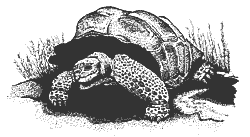|
|
|
|
|
|
Species Spotlight
on
Chelonoidis elephantopus

A.K.A. Galapagos Tortoise Giant Tortoise
DESCRIPTION / COLORATION Typical features include: high domed carapace that is dark brown or black, large plastron, small head, long neck, very heavy legs.
SIZE Length is up to 5 feet; Weight is up to 600 pounds.
HOME Galapagos Islands
HABITAT Dry land.
LIFESTYLE These animals are generally solitary except when breeding, but they may sometimes be found gathered together at food and water sources;
PREDATORS Adult Chelonoidis elephantopus have no enemies with the exception of man. The predators that feed on it's young are mostly animals introduced to the islands by man. They include: rats, cats, and dogs.
FOOD Preferred foods include: grass, leaves, cactus and lichen. Although the Galapagos Tortoise is primarily a vegetarian, in times when plant matter is scarce, it will eat dead crabs, goats, and even dead tortoises.
BREEDING The main breeding season is in February and March however, some tortoises have been known to breed during other times of the year. To attract female tortoises, the male Chelonoidis elephantopus bobs his head and bellows loudly. The female will bury her 4 to 20 eggs in sand or soil. The eggs will hatch after 2 months.
LIFE SPAN This animal can live for over 100 years. Some experts believe that these tortoises can live to even 200 years. It does not reach it's full adult size until it is around 40 years old.
IN THE WILD Chelonoidis elephantopus is threatened directly and indirectly by nonnative animal species introduced into it's home by man. These nonnative species included: rats, cats, dogs, pigs, and goats.
IN CAPTIVITY Galapagos Tortoises are commonly kept and bred in zoos.
SPECIAL CONCERNS This animal is currently endangered nevertheless, various breeding, rehabilitation, and reintroduction programs have been running with success.
INTERESTING FACTS Each of the Galapagos Islands has it's own unique subspecies of Galapagos Tortoise.
For more info see these other websites: